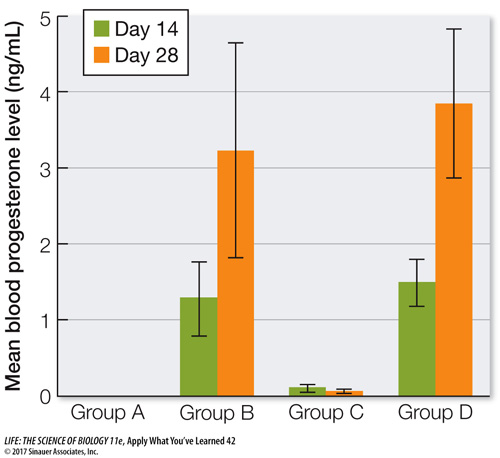Apply What You’ve Learned
Review
42.4
The ovarian and uterine cycles are coordinated and timed by the same hormones that initiate sexual maturation.
Original Paper: Johnston, S. D., P. O’Callaghan, K. Nilsson, G. Tzipori and J. D. Curlewis. 2004. Semen-
Many female mammals, including humans, are spontaneous ovulators, meaning they ovulate in a cyclical pattern; the release of eggs requires no external stimulus. Other female mammals, including camels, rabbits, and koalas, are reflex ovulators; in these females, sexual activity induces ovulation. The females come into estrus but do not ovulate and progress to the luteal phase unless copulation occurs. What is the ovulation “trigger” in these mammals? Is it a pheromone, the physical stimulus of coitus, or a chemical signal in the seminal fluid? Researchers studied female koalas to find the answer.
The goal of Experiment 1 was to determine whether the presence of a male or the physical act of mating stimulates ovulation. Female koalas were separated into two groups of four. On day 2 of estrus, Group A females were paired with males, and mating occurred. Group B females were housed next to males but without physical contact. At intervals following initiation of exposure to males, the researchers took blood samples from the females and measured luteinizing hormone (LH) as the indicator of ovulation. The results of the blood samples indicated that all four females in Group A showed 25 nanogram per milliliter (ng/mL) peaks of LH between 24 and 32 hours postcoitus, and all gave birth 35 days postcoitus. During the same time interval, no females in Group B showed any change in LH hormone levels, and none gave birth.
In Experiment 2, female koalas were separated into four groups of nine. On day 2 of estrus, Group A females underwent an artificial insemination procedure but received 1 mL of 0.9% sterile saline. Group B females were artificially inseminated with 1 mL of koala semen. Group C females had their urogenital sinus artificially stimulated with a glass rod designed to mimic the action of a male koala’s penis during mating. Group D females had the same treatment as females in Group C, followed by artificial insemination with 1 mL of koala semen. At 14 and 28 days after the treatments, the researchers took blood samples from the females and measured levels of progesterone as an indicator of the postovulatory luteal phase. The mean values of blood progesterone levels were calculated for each group and are shown in the figure below.

Questions
1.
Describe the series of events in a female koala’s body that would produce the results in Experiment 1. What potential triggers of ovulation could be eliminated through this experiment?
Following the mating behavior between the male and group A female koalas, the female koala’s pituitary gland released a surge of LH into the bloodstream. This surge in LH stimulated ovulation. An egg was fertilized by the male’s sperm, beginning a period of pregnancy that lasted about 35 days. No LH increases or pregnancies occurred in the Group B females. This experiment eliminates the possibility that the signal for ovulation could be a stimulus, such as a pheromone, from close proximity to a male koala.
2.
Based on the results of Experiment 2, what appears to be the necessary and sufficient stimulus for reflex ovulation in the koala? What potential triggers of ovulation could be eliminated through this experiment?
The results from group A and C show that neither artificial insemination procedures without semen nor tactile stimulation of the urogenital sinus stimulate LH surges or ovulation. However, AI with semen or artificial stimulation followed by semen injection both result in LH surges and ovulation. These results lead to the hypothesis that some component of the male semen is both the necessary and sufficient stimulus for the LH surge and subsequent ovulation. Clearly tactile stimulation alone or injection of a liquid volume into the urogenital sinus did not induce ovulation.
3.
Propose a possible evolutionary advantage of reflex versus spontaneous ovulation.
A possible selective advantage of reflex ovulation is that the female can choose the optimal time and the optimal mate for reproduction. If she has mature eggs available to ovulate, but she is not sexually receptive unless environmental conditions are good and a potential mate is at hand, reflex ovulation can optimize her chances of reproductive success.
Go to LaunchPad for the eBook, LearningCurve, animations, activities, flashcards, and additional resources and assignments.